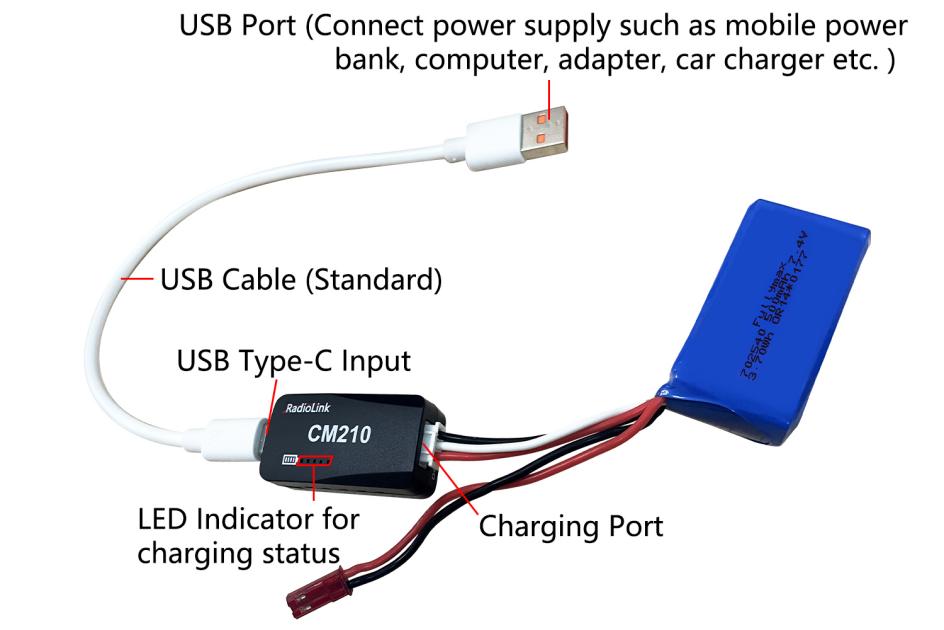Functions
Lowpower precharge: When it is detected that the voltage of a single cell of the battery is lower than 3.0V, a small current is used to activate the battery to restore the battery capacity.
Fast charge: When it is detected that the voltage of a single cell of the battery is higher than 3.0V and lower than 4.16V, 1.5A is used to charge the battery.
Trickle charging: When it is detected that the voltage of a single cell of the battery is higher than 4.16V, 0.8A is used to charge the battery to make the battery fully charged and avoid overcharging.
Temperature control: When it is detected that the board temperature is higher than 75 degrees Celsius, the charging current will be reduced to 2/3 of the predetermined current to lower the board temperature, and when it is detected that the board temperature is lower than 70 degrees Celsius, predetermined current will be restored to charge the battery.
Power supply protection: When it is detected that the power supply voltage drops to 3.7V, the current current is set to a predetermined current to adapt to various charging heads of different specifications.
Balance charging: When the battery voltage is charged to 4.16V, if it is detected that the voltages of the two batteries are not equal, the balance charging is turned on to ensure that the battery voltages are consistent.
Charging alarm: When there is no current detected for a long time, charging will be automatically stopped, and the red LED will flash to indicate abnormality.
Charging time: About 40 minutes for a 500mAH 2S battery.
Voltage precision: The full voltage is 4.20V±0.02V.
Charging efficiency: Higher than 82%.
Speficifications
Size: 40.5*21*15 mm
Weight: 9g
Input Voltage: 5V
Supporting Battery: 2S LiPo battery
Charging Precision: 0.02V
Charging Voltage: Max. 4.2V for each battery cell
Charging Current: 1.5A
Balance Current: 0.8A
Max. Output Power: 20WPower Supply Input Port: USB Type-C InputCharging Port Interface: 2S battery balance port
Working Modes: Charging Mode, Balance Mode, Repair Mode (Self-adaptive, with no need to set it)
Instructions for Use
Insert one end of the standard USB cable into the Type-C input port of the CM210 charger (as shown in the picture below), and then connect the other end of the USB cable to power supply equipment such as power bank, computer, mobile phone adapter, etc.. After the right connection, the red LED indicator will be always on.
Insert the balance port of the standard 2S lithium battery of A560 into the charging port of CM210 (as shown in the picture below). Then the green LED indicator starts flashing, which means it starts to charge the battery. (Note: The green LED indicator flashes during the charging to indicate normal charging; If the red LED indicator flashes during the charging to indicate abnormal charging. Please reconnect battery and cable to troubleshoot the abnormality.)
When all four LED indicators turn solid green, the battery is fully charged, and the charger will automatically stop charging.
Remove the battery and then disconnect the power supply.

LED Indicator Status
Voltage Calibration of CM210
Three power supplies are required. Two 5V power supplies at the battery end, with 0.1A current. When the battery end is connected, turn on the battery end power supply. The voltage of the charging end power supply is set to 5V, with 3A current. When the power supply end is connected, turn on the charging end power supply. Then the MCU runs the calibration program inside . When all the green LED indicators are on at the same time and then go out, the calibration is completed
Troubleshooting for Common Problems
1. After the charger is powered on, the red light flashes just after inserting the battery or within 1 minute.
The current detection resistor is burned out, and the MCU detects that the current is too large.
The switch tube is damaged, so it is unable to switch normally. There is no current output or the output current of the power supply is too small.
2. After the charger is powered on, insert the battery and charging works normally for a period of time, and then the red light flashes.
The output current of the power supply is too small, or the battery is damaged.
Solution: Replace the power supply or battery to charge it again, if the abnormal phenomenon still occurs, the charger is damaged.